3-D Printed Fabry–Pérot Resonator Antenna with Paraboloid-Shape Superstrate for Wide Gain Bandwidth
Abstract
:1. Introduction
2. Resonant Condition for FPRA
3. Design of the Proposed FPRA with Wide Gain Bandwidth
3.1. Configuration of the Proposed FPRA
3.2. FPRA with a Traditionial Planar Superstrate
3.3. Proposed FPRA with a Paraboloid-Shpae Superstrate
4. Fabrication, Measurements, and Discussion
5. Conclusions
Acknowledgments
Author Contributions
Conflicts of Interest
References
- Trentini, G.V. Partially reflecting sheet arrays. IRE Trans. Antennas Propag. 1956, 4, 666–671. [Google Scholar] [CrossRef]
- Feresidis, A.P.; Vardaxoglou, J.C. High gain planar antenna using optimised partially reflective surfaces. IEE Proc. Microw. Antennas Propag. 2001, 148, 345–350. [Google Scholar] [CrossRef]
- Weily, A.R.; Esselle, K.P.; Sanders, B.C.; Bird, T.S. High-gain 1D EBG resonator antenna. Microwave Opt. Technol. Lett. 2005, 47, 107–114. [Google Scholar] [CrossRef]
- Chen, X.; Luo, Z.; Zheng, Z.; Feng, P.; Huang, K. Effective reflective characteristics of superstrates and their effects on the resonant cavity antenna. IEEE Trans. Antennas Propag. 2015, 63, 1572–1580. [Google Scholar] [CrossRef]
- Weily, A.R.; Horvath, L.; Esselle, K.P.; Sanders, B.C.; Bird, T.S. A planar resonator antenna based on a woodpile EBG material. IEEE Trans. Antennas Propag. 2005, 53, 216–223. [Google Scholar] [CrossRef]
- Vaidya, A.R.; Gupta, R.K.; Mishra, S.K.; Mukherjee, J. High-gain low side lobe level fabry perot cavity antenna with feed patch array. Prog. Electromagn. Res. C 2012, 28, 223–238. [Google Scholar] [CrossRef]
- Li, Y.; Mittra, R.; Zeng, B.; Lu, G.; Li, Z.; Liu, J.; Chang, D.C. Directivity enhancement of fabry-perot antenna by using a stepped-dielectric slab superstrate. Microw. Opt. Technol. Lett. 2012, 54, 711–715. [Google Scholar] [CrossRef]
- Ge, Y.; Esselle, K.P.; Bird, T.S. The use of simple thin partially reflective surfaces with positive reflection phase gradients to design wideband, low-profile EBG resonator antennas. IEEE Trans. Antennas Propag. 2012, 60, 743–750. [Google Scholar] [CrossRef]
- Liu, Z.G. Fabry-Perot resonator antenna. J. Infrared Millim. Terahertz Waves 2010, 31, 391–403. [Google Scholar] [CrossRef]
- Guérin, N.; Enoch, S.; Tayeb, G.; Sabouroux, P.; Vincent, P.; Legay, H. A metallic Fabry-Perot directive antenna. IEEE Trans. Antennas Propag. 2006, 54, 220–224. [Google Scholar] [CrossRef]
- Hashmi, R.M.; Esselle, K.P. A class of extremely wideband resonant cavity antennas with large directivity-bandwidth products. IEEE Trans. Antennas Propag. 2016, 64, 830–835. [Google Scholar] [CrossRef]
- Liu, Z.; Zhang, W.; Fu, D.; Gu, Y.; Ge, Z. Broadband Fabry-Perot resonator printed antennas using FSS superstrate with dissimilar size. Microw. Opt. Technol. Lett. 2008, 50, 1623–1627. [Google Scholar] [CrossRef]
- Yeo, J.; Kim, D. Novel design of a high-gain and wideband Fabry-Perot cavity antenna using a tapered AMC substrate. J. Infrared Millim. Terahertz Waves 2009, 30, 217–224. [Google Scholar] [CrossRef]
- Wang, N.; Liu, Q.; Wu, C.; Talbi, L.; Zeng, Q.; Xu, J. Wideband Fabry-Perot resonator antenna with two complementary FSS layers. IEEE Trans. Antennas Propag. 2014, 62, 2463–2471. [Google Scholar]
- Wang, N.; Li, J.; Wei, G.; Talbi, L.; Zeng, Q.; Xu, J. Wideband Fabry–Perot resonator antenna with two layers of dielectric superstrates. IEEE Antennas Wirel. Propag. Lett. 2015, 14, 229–232. [Google Scholar] [CrossRef]
- Feresidis, A.P.; Vardaxoglou, J.C. A broadband high-gain resonant cavity antenna with single feed. In Proceedings of the European Conference on Antennas and Propagation, Nice, France, 6–10 November 2006; Volume 626, pp. 1–5. [Google Scholar]
- Konstantinidis, K.; Feresidis, A.P.; Hall, P.S. Multilayer partially reflective surfaces for broadband Fabry-Perot cavity antennas. IEEE Trans. Antennas Propag. 2014, 62, 3474–3481. [Google Scholar] [CrossRef]
- Weily, A.R.; Esselle, K.P.; Bird, T.S.; Sanders, B.C. Dual resonator 1-D EBG antenna with slot array feed for improved radiation bandwidth. IET Microw. Antennas Propag. 2007, 1, 198–203. [Google Scholar] [CrossRef]
- Du, G.; Liang, M.; Sabory-Garcia, R.A.; Liu, C.; Xin, H. 3-D printing implementation of an X-band Eaton lens for beam deflection. IEEE Antennas Wirel. Propag. Lett. 2016, 15, 1487–1490. [Google Scholar] [CrossRef]
- Guo, C.; Shang, X.; Li, J.; Zhang, F.; Lancaster, M.J.; Xu, J. A Lightweight 3-D Printed X-Band Bandpass Filter Based on Spherical Dual-Mode Resonators. IEEE Microw. Wirel. Compon. Lett. 2016, 26, 568–570. [Google Scholar] [CrossRef]
- Zhang, B.; Zirath, H. Metallic 3-D printed rectangular waveguides for millimeter-wave applications. IEEE Trans. Compon. Packag. Manuf. Technol. 2016, 6, 796–804. [Google Scholar] [CrossRef]
- Barton, J.H.; Garcia, C.R.; Berry, E.A.; Salas, R.; Rumpf, R.C. 3-D printed all-dielectric frequency selective surface with large bandwidth and field of view. IEEE Trans. Antennas Propag. 2015, 63, 1032–1039. [Google Scholar] [CrossRef]
- Sage, G.P.L. 3D printed waveguide slot array antennas. IEEE Access 2016, 4, 1258–1265. [Google Scholar] [CrossRef]
- Chieh, J.C.S.; Dick, B.; Loui, S.; Rockway, J.D. Development of a ku-band corrugated conical horn using 3-d print technology. IEEE Antennas Wirel. Propag. Lett. 2014, 13, 201–204. [Google Scholar] [CrossRef]
- Moustafa, L.; Jecko, B. Broadband high gain compact resonator antennas using combined FSS. In Proceedings of the Antennas and Propagation Society International Symposium, San Diego, CA, USA, 5–11 July 2008; pp. 1–4. [Google Scholar]
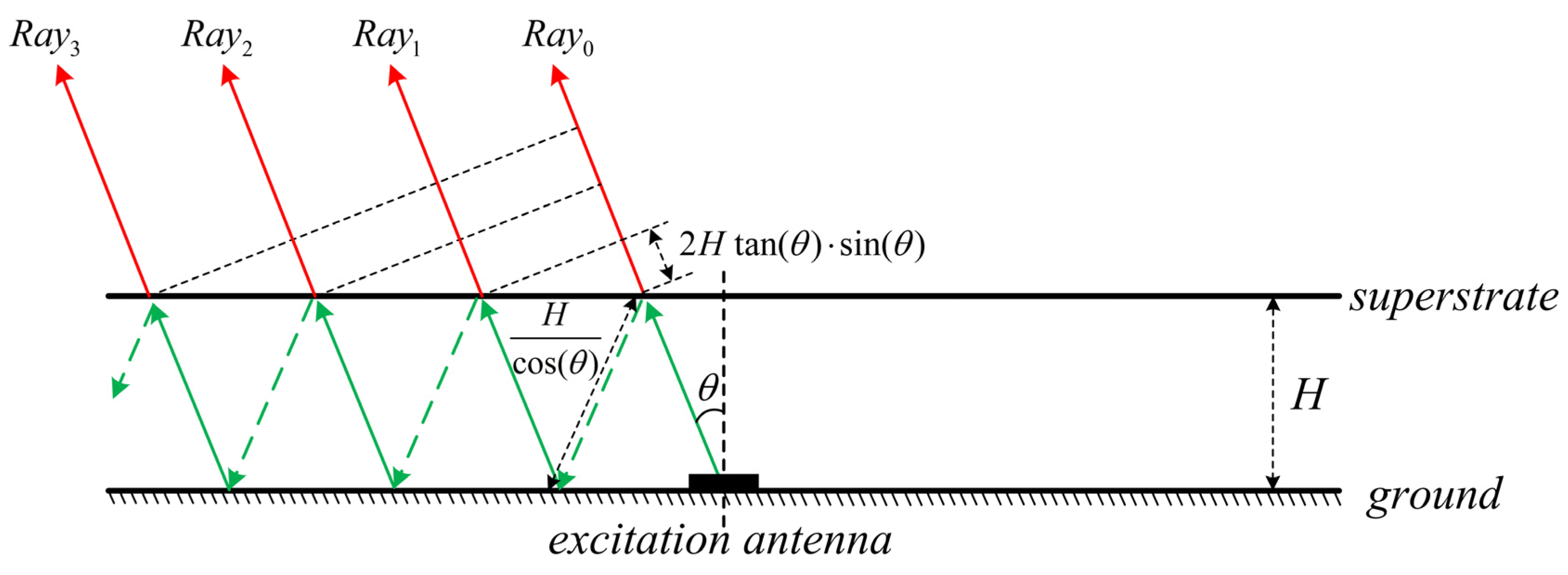
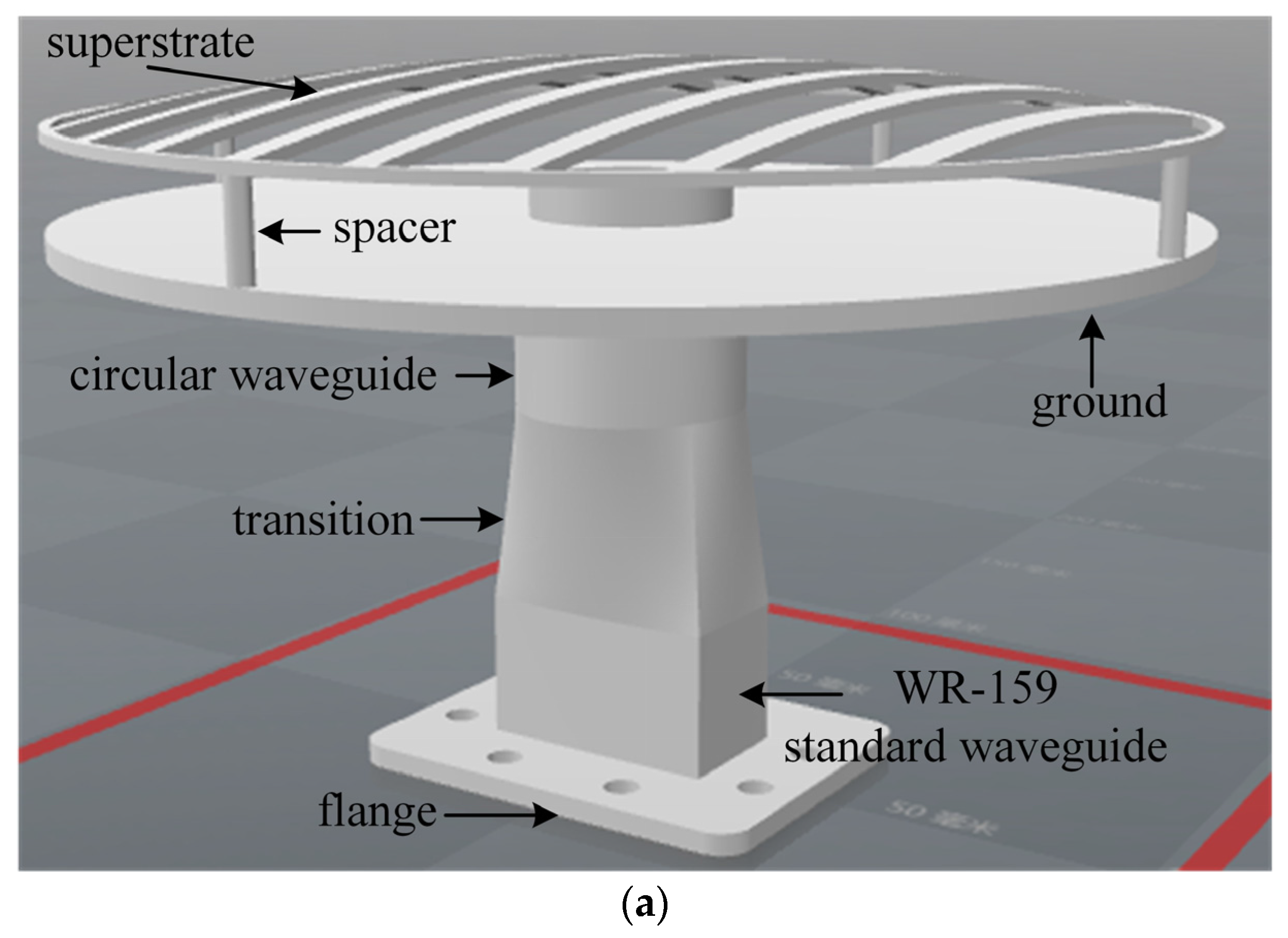

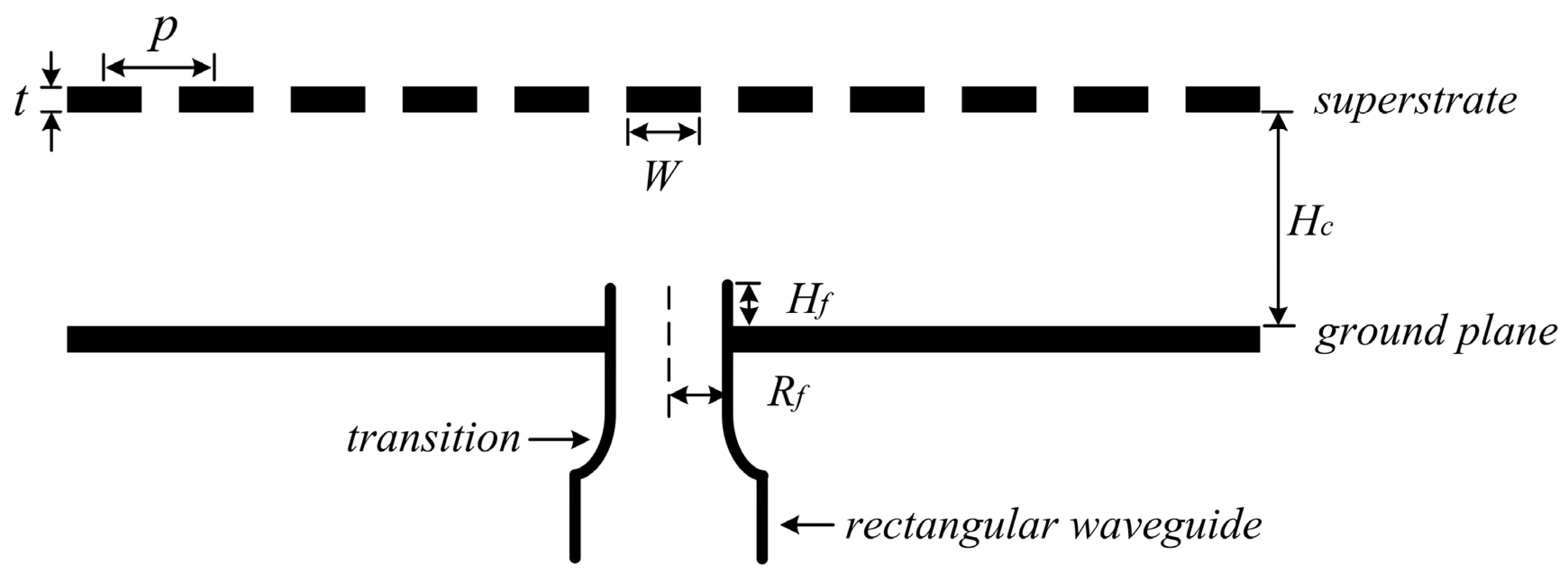
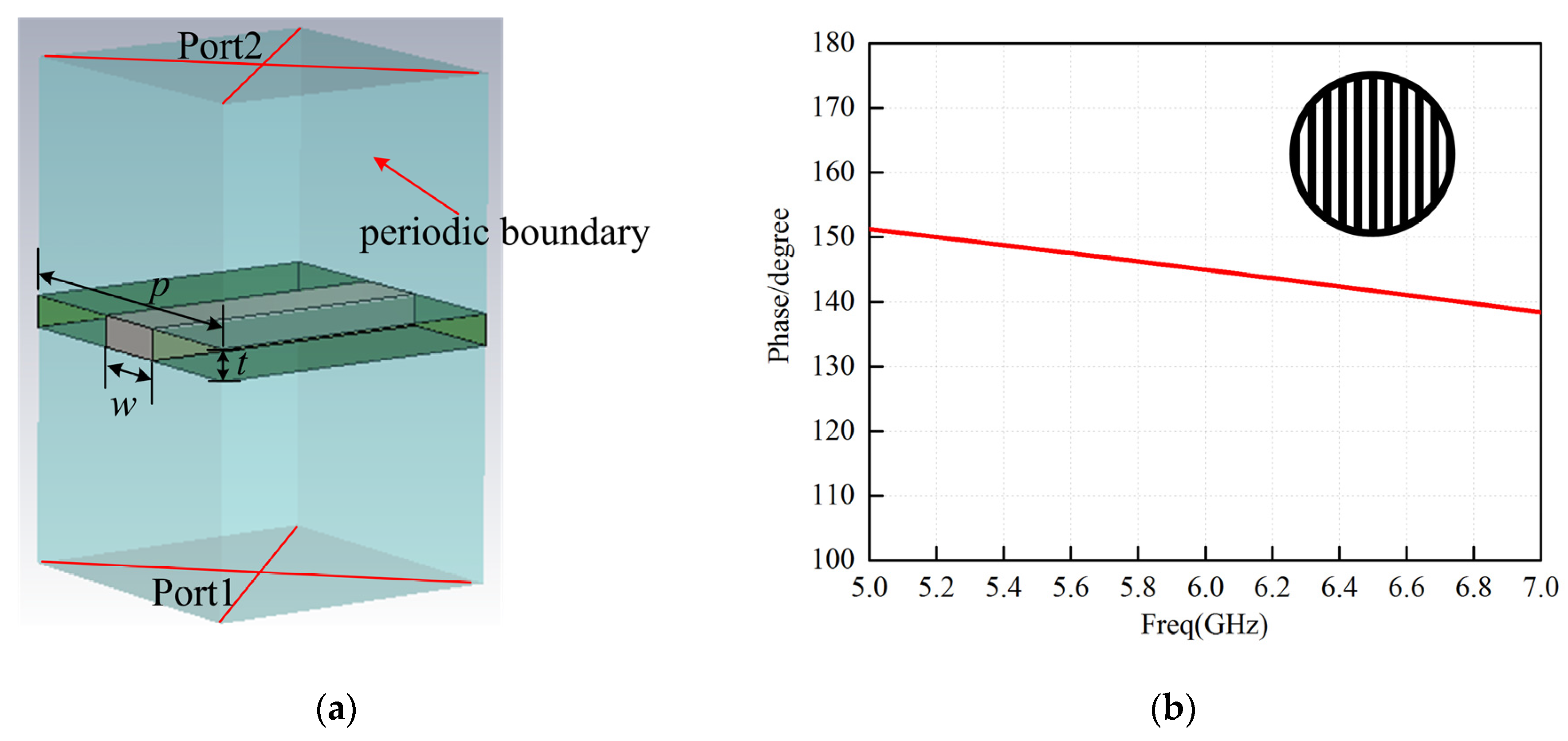
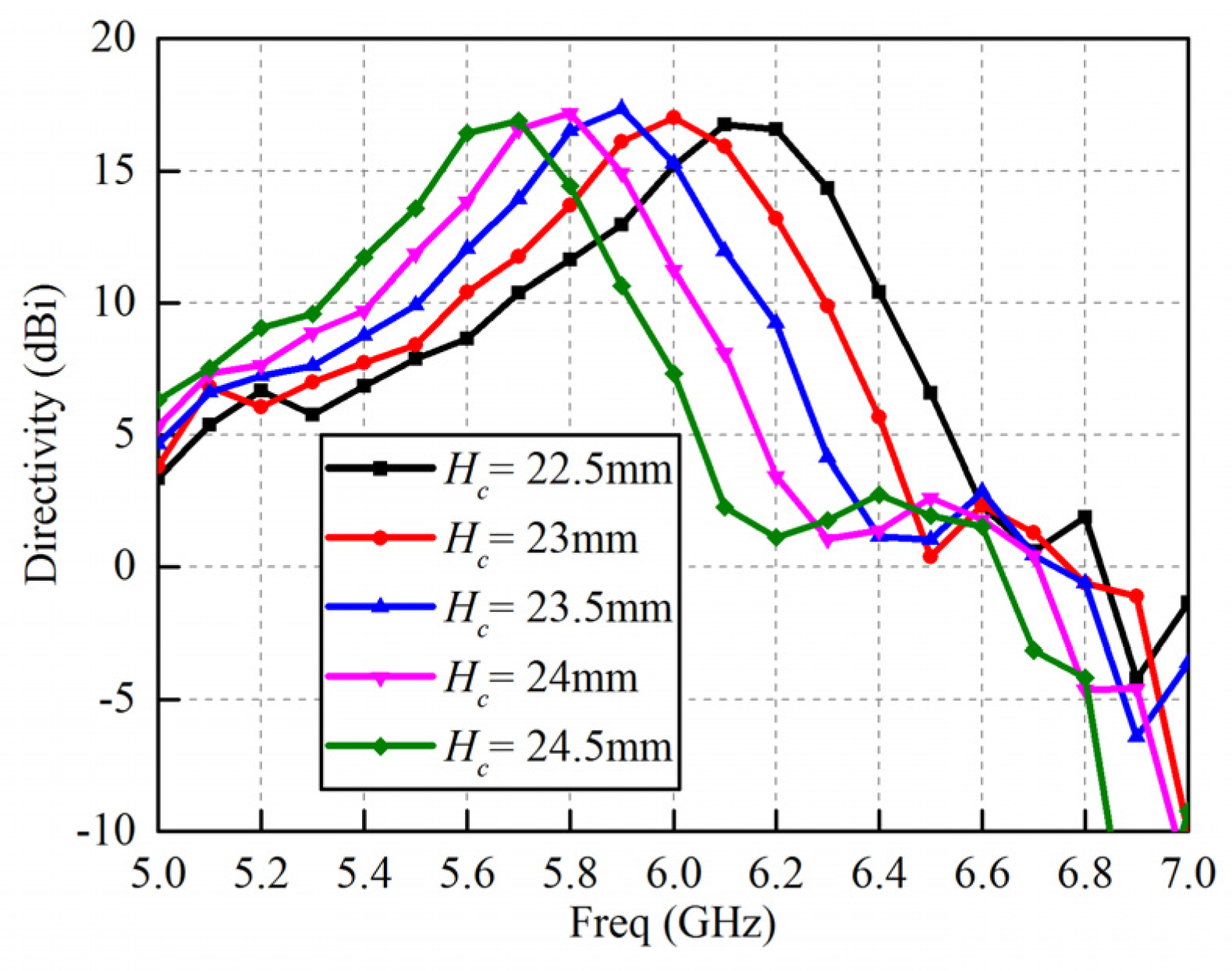

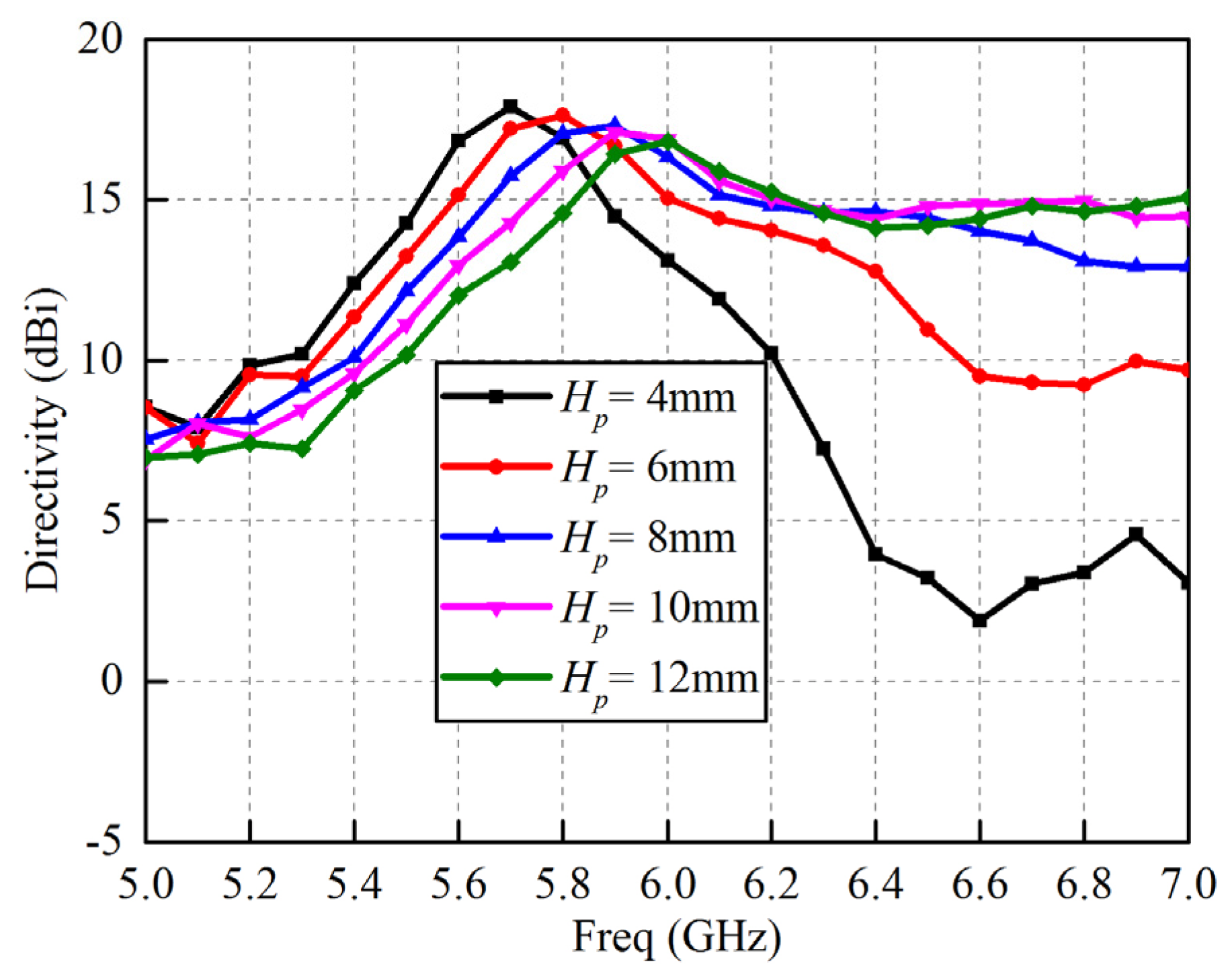
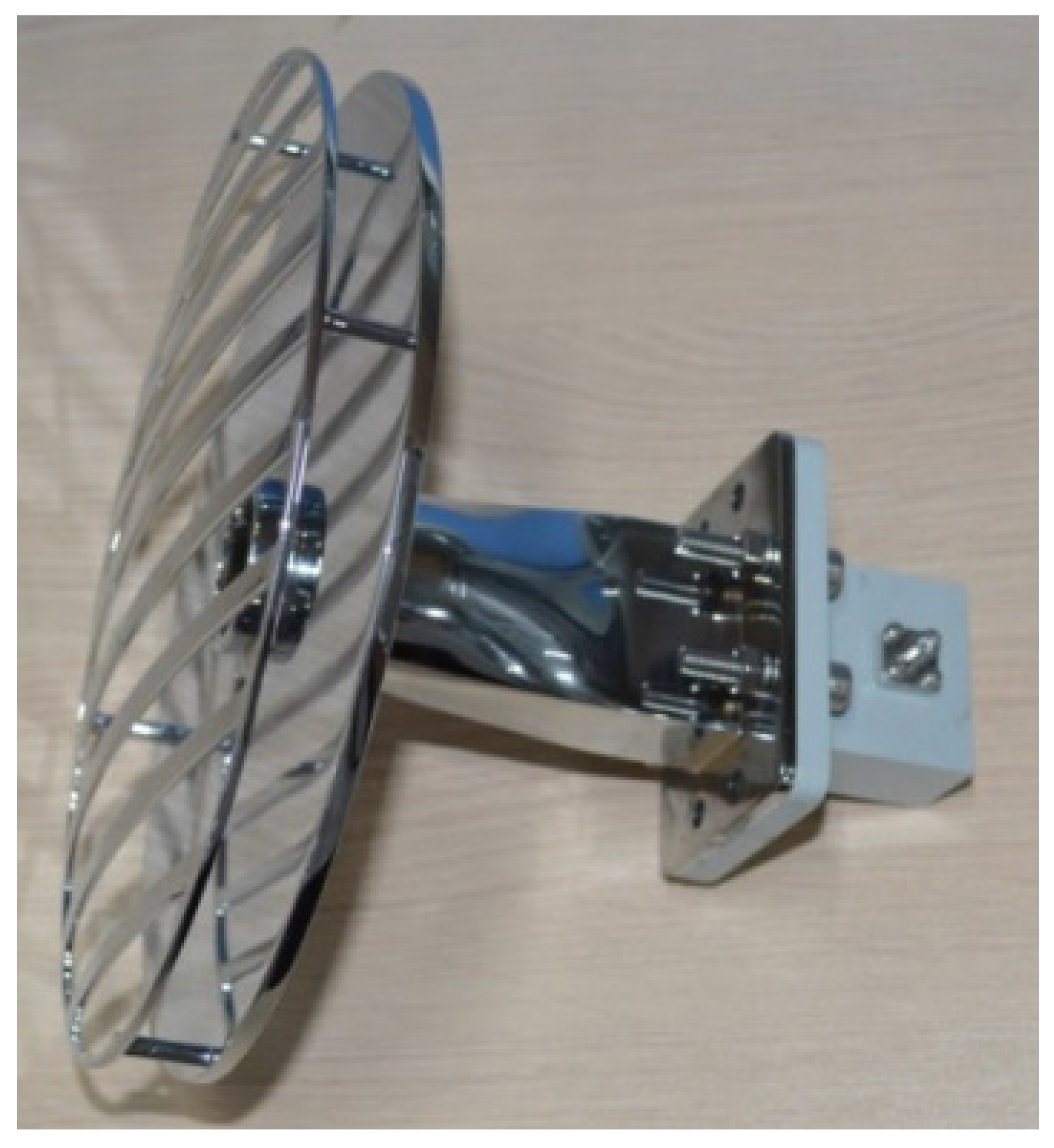
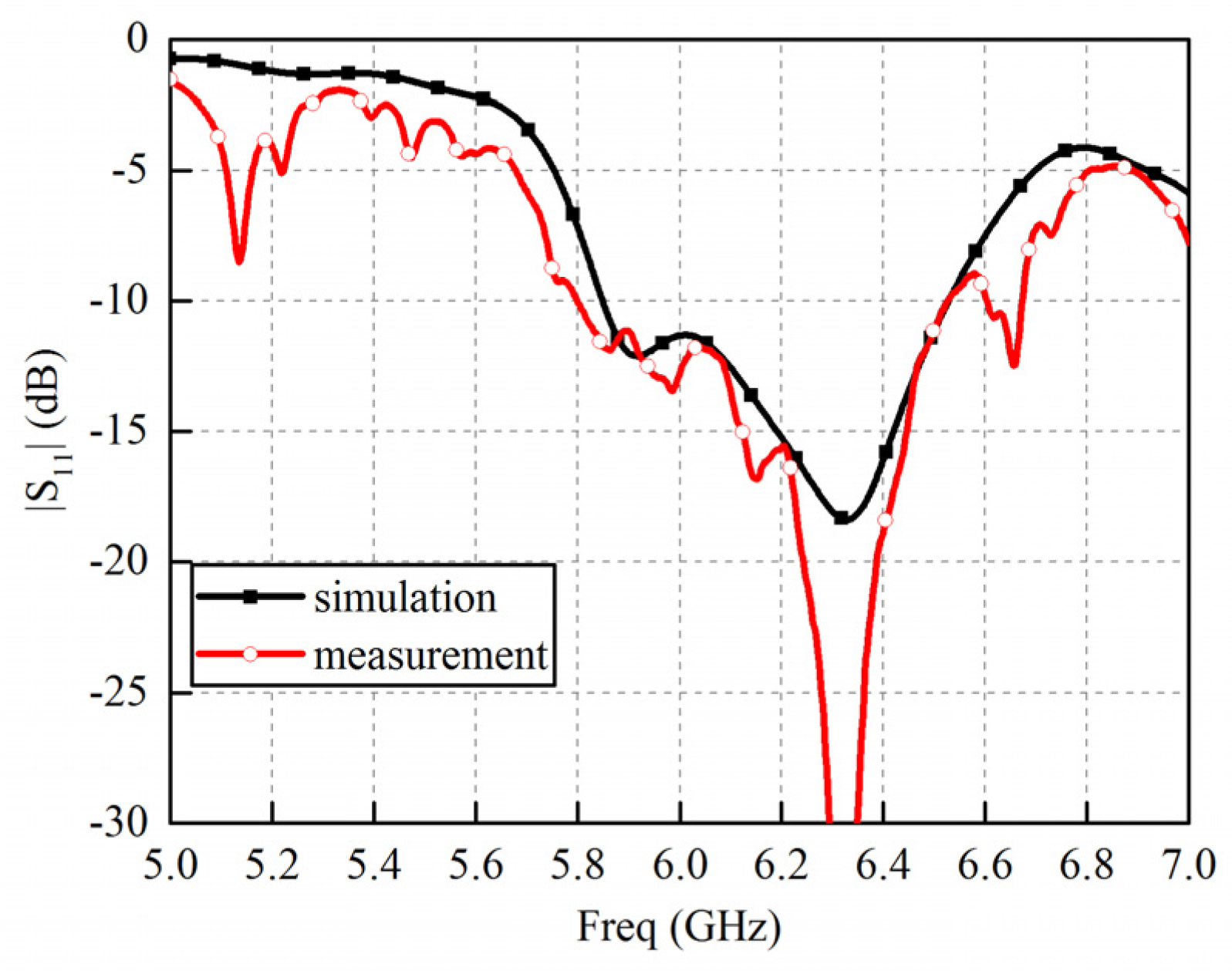

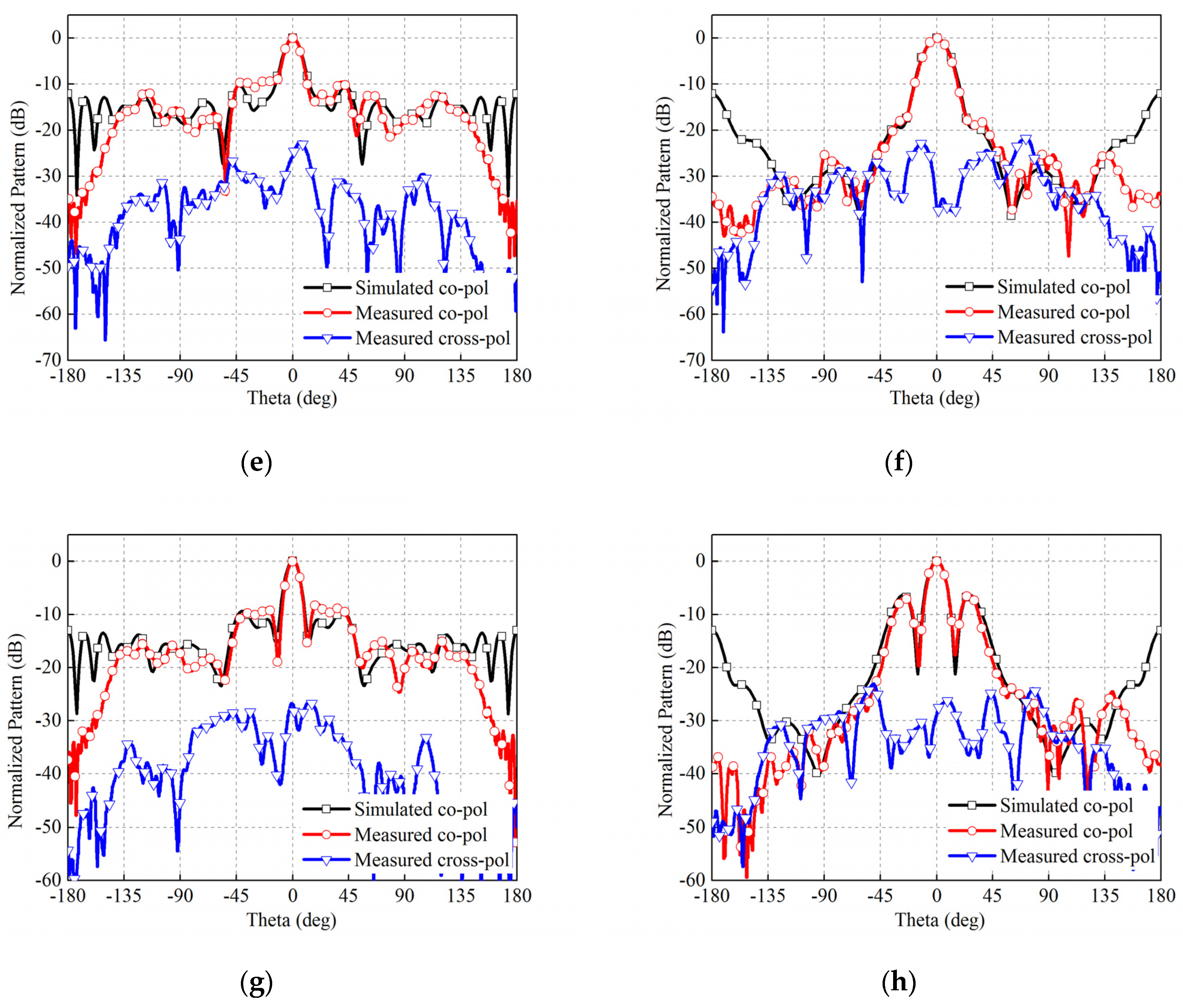
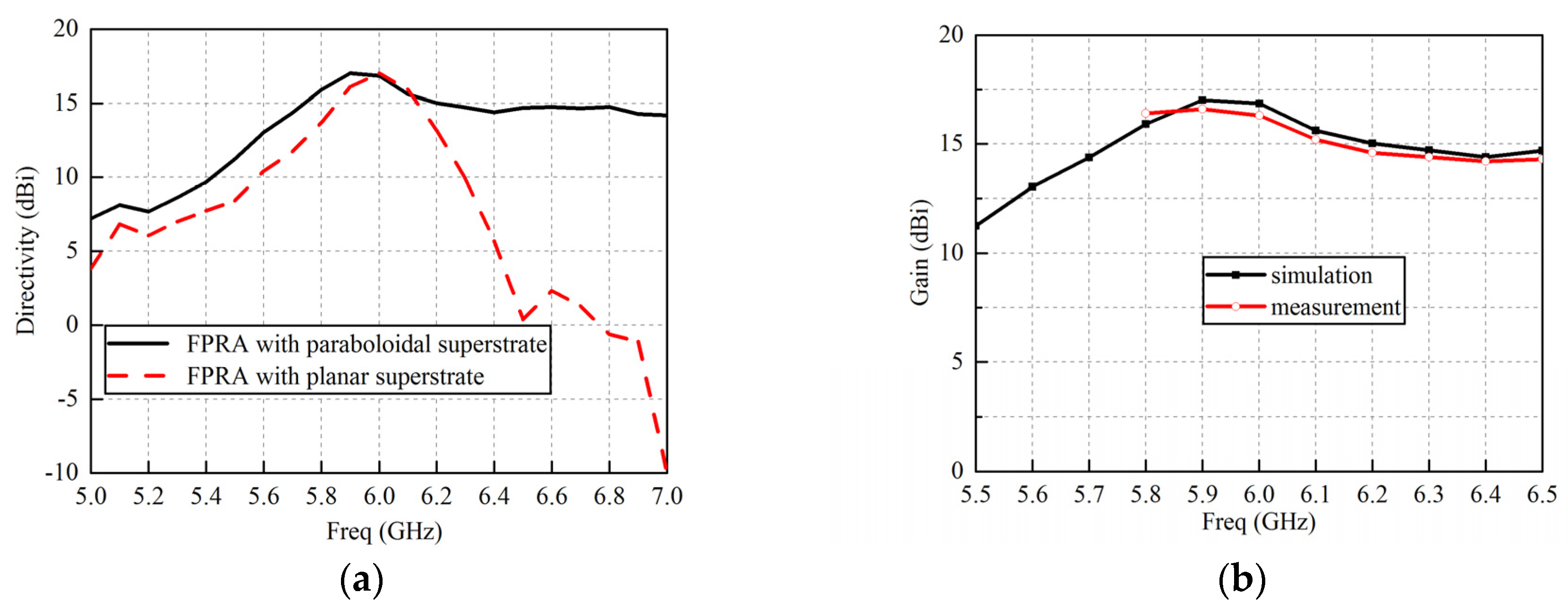
© 2017 by the authors. Licensee MDPI, Basel, Switzerland. This article is an open access article distributed under the terms and conditions of the Creative Commons Attribution (CC BY) license (http://creativecommons.org/licenses/by/4.0/).
Share and Cite
Chen, Q.; Chen, X.; Xu, K. 3-D Printed Fabry–Pérot Resonator Antenna with Paraboloid-Shape Superstrate for Wide Gain Bandwidth. Appl. Sci. 2017, 7, 1134. https://doi.org/10.3390/app7111134
Chen Q, Chen X, Xu K. 3-D Printed Fabry–Pérot Resonator Antenna with Paraboloid-Shape Superstrate for Wide Gain Bandwidth. Applied Sciences. 2017; 7(11):1134. https://doi.org/10.3390/app7111134
Chicago/Turabian StyleChen, Qiang, Xing Chen, and Ke Xu. 2017. "3-D Printed Fabry–Pérot Resonator Antenna with Paraboloid-Shape Superstrate for Wide Gain Bandwidth" Applied Sciences 7, no. 11: 1134. https://doi.org/10.3390/app7111134




